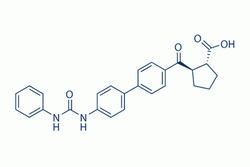| Description: |
A 922500 is a potent, selective, and orally bioavailable DGAT-1 inhibitor exhibiting IC50s of 9 and 22 nM against human and mouse DGAT-1, respectively. |
| Target: |
IC50: 9 nM (human DGAT-1), 22 nM (mouse DGAT-1)[1] |
| In Vivo: |
DGAT-1 inhibitor A 922500 (A-922500) reduces serum triglyceride levels from baseline at all doses tested; however, this is only statistically significant at the 3 mg/kg dose, which lowers serum triglycerides by 53%. Similarly, the 3 mg/kg dose of A 922500 significantly reduces serum FFA concentrations by 55% and total cholesterol by 25%. DGAT-1 inhibition has no significant effect on body weight at any dose tested. Although A 922500 dpes not significantly affect LDL-cholesterol or HDL-cholesterol individually, the serum LDL/HDL-cholesterol ratio is significantly improved by A 922500 at 0.3 and 3 mg/kg. Similar to the dyslipidemic hamster, treatment with 3 mg/kg A 922500 significantly reduces serum triglyceride concentrations (39%). FFA levels significantly increase over the 14-day period in vehicle-treated animals. This increase is inhibited in a dose-dependent manner by A 922500 such that FFA concentrations are 32% lower after 14 days of treatment with the DGAT-1 inhibitor at 3 mg/kg, compared with the vehicle group (p < 0.05). HDL-cholesterol is significantly increased from baseline levels by A 922500 at 0.3 and 3 mg/kg; however, this is only significantly increased compared with vehicle at the 3 mg/kg dose. Body weight significantly increases over the 2-week period in vehicle-treated rats, and this is not affected by A 922500. LDL-cholesterol is significantly reduced in the vehicle treated group. DGAT-1 inhibition does not further reduce LDL-cholesterol and has no effect on total cholesterol[1]. |
| In Vitro: |
A 922500 (A-922500) demonstrates excellent selectivity over other acyltransferases, including DGAT-2 (IC50=53 μM) and the phylogenetic family members acyl coenzyme A cholesterol acyltransferase-1 and -2 (IC50=296 μM) [1]. |
| Animal Administration: |
Mice and Hamsters[1] Thirteen-week-old male Golden Syrian hamsters (n=40), initially weighing approximately 140 g, are used. Ten-week-old Male Zucker fatty rats (n=32), weighing between 270 and 330 g, are used. After collection of baseline lipid profiles, hyperlipidemic hamsters (n=10/group) and Zucker fatty rats (n=8/group) are administered vehicle [20:80 (v/v), polyethylene glycol/hydroxypropyl-β-cyclodextrin (10% w/v)] or DGAT-1 inhibitor A 922500 (A-922500) at 0.03, 0.3, and 3 mg/kg, once daily by oral gavage. The dosing volume is 5 mL/kg. Serum lipid profiles are then measured 3 h after the dose on day 7 and day 14. Hamsters continue to be fed a high-fat diet with 10% fructose in the drinking water throughout the treatment period. Zucker fatty rats remain on standard rodent diet throughout the study. |
| References: |
[1]. King AJ, et al. Diacylglycerol acyltransferase 1 inhibition lowers serum triglycerides in the Zucker fatty rat and the hyperlipidemic hamster. J Pharmacol Exp Ther. 2009 Aug;330(2):526-31. |






















